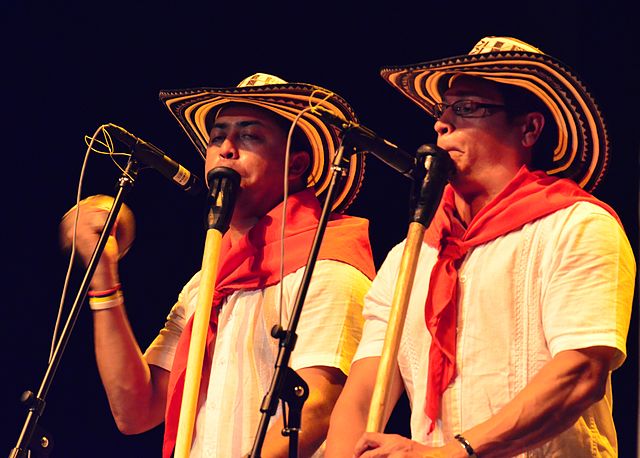The Gaita: Soulful Flute of Cumbia

The Gaita, a traditional Colombian flute, is not just an instrument; it’s the soulful voice of Cumbia music. Jump into mystical world of the Gaita, exploring its origins, unique construction, and the significant role it plays in the rhythmic and melodious landscape of Cumbia. Journey through the historical significance of the Gaita and celebrate the artists who have brought this instrument to the forefront of Colombian folklore and global stages.
Roots of the Gaita
The Gaita, primarily used by the indigenous Kogui and Ika tribes of Colombia’s Sierra Nevada, has a rich history dating back centuries. Its creation is more than just the crafting of a musical instrument; it’s a symbol of cultural identity and tradition. Understanding the Gaita’s history is crucial in appreciating its role in Cumbia music.
Craftsmanship of the Gaita
The construction of a Gaita is a time-honored art, using natural materials like cactus for the body and beeswax mixed with charcoal for the mouthpiece. Here are some of the intricacies of how Gaitas are made and the impact of their construction on their distinctive sound.
- Material Selection: The body of the Gaita is traditionally made from a type of cactus known as “cardón.” Artisans carefully select this cactus for its natural hollow structure, which is essential for the instrument’s acoustic properties. The cactus is dried and cleaned to create a smooth, resonant tube.
- Mouthpiece Construction: The mouthpiece, or “boquilla,” is crafted from a mixture of beeswax and charcoal. This combination is chosen for its ability to create a tight seal with the player’s lips while also being malleable enough to adjust for pitch and tone. The charcoal adds rigidity to the beeswax, ensuring the mouthpiece retains its shape.
- Fingering Holes: Precise placement and sizing of the fingering holes are crucial for the Gaita’s melodic range. Artisans use traditional tools to carve these holes, ensuring they are evenly spaced and properly aligned. The size of each hole affects the pitch of the notes, allowing for the creation of the Gaita’s distinctive melodies.
- Decoration: While the primary focus is on the instrument’s sound, the aesthetic aspect is also important. Gaitas are often adorned with intricate designs, using natural dyes or carvings. These decorations reflect the cultural heritage of the region and add a personal touch to each instrument.
- Tuning: Once the Gaita is constructed, it undergoes a careful tuning process. Artisans use their expertise to adjust the length of the cactus tube and the position of the fingering holes to achieve the desired pitch. This fine-tuning ensures that the Gaita blends harmoniously with other instruments in a Cumbia ensemble. Each step in the process, from the selection of materials to the final tuning, is imbued with tradition and skill. The result is an instrument that not only produces beautiful music but also carries the soul of Colombian folklore.
Masters of the Gaita
Notable Gaita players, such as Juan “Chuchita” Fernández and Totó la Momposina, have been instrumental in popularizing this instrument. Their contributions extend beyond performance; they embody the spirit of Cumbia and its roots.
Playing the Gaita
Playing the Gaita involves a unique technique that is quite distinct from other flutes. Learn the basics of Gaita playing techniques, from breath control to finger positioning, and how these techniques contribute to the evocative sound that defines Cumbia music.
- Breath Control: One of the key aspects of playing the Gaita is mastering breath control. Players must learn to produce a steady, controlled airflow to maintain the instrument’s characteristic sound. This involves using diaphragmatic breathing to ensure a consistent volume and tone throughout a performance.
- Finger Positioning: The Gaita has a specific set of fingering holes, and the player’s finger positioning on these holes determines the notes produced. Players must develop precision in covering and uncovering the holes to create the desired melody. The technique is similar to other woodwind instruments but adapted to the Gaita’s unique structure.
- Circular Breathing: Advanced Gaita players often use a technique called circular breathing, which allows them to maintain a continuous sound without pausing for breath. This involves breathing in through the nose while simultaneously pushing air out through the mouth using the cheeks. It’s a challenging technique that requires practice but is essential for performing longer pieces.
- Vibrato: Adding vibrato to the sound is another technique used by Gaita players. This involves subtly varying the air pressure and finger pressure on the holes to create a slight oscillation in pitch. Vibrato adds depth and emotion to the music, making it more expressive.
- Articulation: The way a player articulates notes on the Gaita greatly impacts the overall sound. Techniques such as tonguing (using the tongue to start and stop notes) and slurring (connecting notes smoothly) are used to create different effects and add rhythmical interest to the music.
- Dynamics: Controlling the dynamics, or volume levels, is crucial in Gaita playing. Players must be able to produce both soft, subtle sounds and powerful, resonant tones, depending on the musical context. This dynamic range is what gives the Gaita its emotional impact.
The art of playing the Gaita is a complex and nuanced skill that requires dedication and practice.
Fusion and Evolution
As Cumbia music evolved, so did the role of the Gaita. Modern Cumbia bands have found innovative ways to incorporate this traditional instrument into their music, creating a fusion that respects tradition while embracing contemporary styles. Current artists are keeping the Gaita relevant in today’s music scene.
The Gaita remains a cornerstone of Cumbia music, a bridge between the past and the present. Its haunting melodies continue to resonate, telling stories of culture, tradition, and musical innovation. As we continue to explore the depths of Cumbia, the Gaita stands as a testament to the enduring power of music to transcend time and connect us to our roots.
Photo credit: SolReyes @ Wikimedia